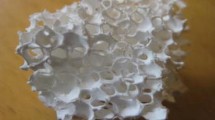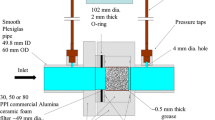Abstract
The mathematical model to compute the efficiency of depth filtration of molten aluminum, previously presented in Part I, was further developed and applied to study long-term filtration. In this case, the incoming suspension entering the unit cell was not assumed homogeneous, and the times and positions of particle at the inlet were obtained stochastically from a random number generator. The particles that were transported by the fluid flow to the wall and collided against this surface remained attached to the wall and accumulated within the domain. The accumulation of particles decreased the effective area for fluid to flow through the pore, causing distortion of the overall velocity field in the domain. The flow field was obtained from the numerical solution of the continuity and Navier-Stokes equations for transient flow, the particle trajectories were calculated using the Langrangian motion equation including the buoyancy, and the viscous drag force corrected for the wall effect. The model predicted a preferred particle accumulation around the windows to form a cake of particles and the effect that inclusion accumulation has on the flow field, pressure drop, and filtration coefficient. This work studied the influence of particle concentration and fluid velocity on the evolution of the filtration coefficient and pressure drop. It was found that these quantities were practically constant for TiB2 particles suspended in aluminum at a concentration of 1 ppm and filtered during 60 minutes through the unit cell of a 30 ppi foam filter. However, at a particle concentration of 10 ppm, the model predicted that the filtration coefficient and pressure drop changed appreciably for the same period of filtration. The results, obtained from first principles, provide a rationale to explain fluctuations of the filtration coefficient and pressure drop, reported in the literature, without introducing any empirical or probability factor in the respective equations.
Similar content being viewed by others
Abbreviations
- A, A p :
-
downstream face area of a control volume and projection area of a particle, respectively (mm2)
- C :
-
Eulerian particle concentration in the melt that flows through a filter (g/cm3)
- C i , C o :
-
particle concentration in the melt at the inlet and at the outlet of the filter, respectively
- c p :
-
particle concentration in the melt before filtration (ppm, g/cm3, vol pct)
- d p , d w , d c :
-
particle, window, and pore diameters (mm)
- d u :
-
real number, from zero to one, obtained with a pseudo-random number generator and used in Eq. [2] to determine the radial position r in
- g :
-
gravitational acceleration, 9.8 m/s2
- h :
-
distance between successive windows (mm)
- I t , I t (i):
-
average interarrival time between particles, Eq. [3], and pseudo-random interarrival time (s), Eq. [4]
- L :
-
filter thickness (cm)
- N Re :
-
Reynolds number, N Re = U i d c /v
- p :
-
Eulerian pressure in the fluid (Pa)
- ΔP 0 UC , ΔP UC :
-
initial and instantaneous pressure drop through a pore of a unit cell, respectively
- P FA , P FV :
-
porosity factors of area and volume, EQs. (Ia) and (Ib), respectively
- Q :
-
voluminic flow rate (cm3/s)
- r, z :
-
coordinate distances in the radial and axial directions, respectively (mm)
- r in :
-
radial position of a particle entering the computational domain (mm)
- r w :
-
radius of the pore window (mm)
- R :
-
radius of the suspended particle (mm)
- t :
-
time (s, min)
- t i , t i + 1 :
-
times at temporal nodes i and i + 1, respectively
- T :
-
period of filtration, s
- u :
-
Eulerian velocity vector of the fluid (cm/s)
- U i :
-
interstitial melt velocity (U m /ε) (cm/s)
- U m :
-
melt superficial velocity (Q/A) (cm/s)
- u ∞ :
-
particle terminal velocity (cm/s)
- Δu z :
-
percent of change in the local axial velocity, with respect to the velocity in a clean filter
- V, V p :
-
volume of a control volume and of a single particle (cm3)
- ε :
-
filter porosity (pct)
- φ :
-
azimuthal angle (radians)
- η :
-
filtration efficiency of the filter defined by (C i − C o )/C i × 100 (pct)
- η t :
-
average filtration efficiency defined by Eq. [5]
- λ :
-
filtration coefficient (m−1)
- μ, v :
-
dynamic and kinematic melt viscosities (Pa*s and m2/s), respectively
- π :
-
constant, 3.141592654
- ρ, ρ p :
-
density of the fluid and particle, respectively (kg/m3)
- σ :
-
specific deposit
References
C. Tien: Granular Filtration of Aerosols and Hydrosols, Butterworth and Co., Stoneham, MA, 1989, pp. 317–26.
C. Wang, M. Beizaie, and C. Tien: AIChE J., 1977, vol. 23 (6), pp. 879–89.
R.I. Mackie, R.M.W. Horner, and R.J. Jarvis: AIChE J., 1987, vol. 33 (11), pp. 1761–75.
G.N. Constantinides and A.C. Payatakes: AICHE J., 1996, vol. 42 (2), pp. 369–82.
V.N. Burganos, C.A. Paraskeva, and A.C. Payatakes: J. Colloid Interface Sci., 1992, vol. 148 (1), pp. 167–81.
A.C. Payatakes, H.Y. Park, and J. Petrie: J. Chem. Eng. Sci., 1981, vol. 36, pp. 1319–35.
D. Apelian, S. Luk, T. Piccone, and R. Mutharasan: Steelmaking Proc. 5th Int. Iron & Steel Congr., Washington, DC, 1986, ISS, Warrendale, PA, 1986, vol. 69, pp. 957–67.
J.P. Desmoulins, H. d’Hondt, J.M. Hicter, and P. Neter: Proc. 118th TMS Light Metals Annual Meeting, Las Vegas, NV, Feb. 27–Mar. 3, 1989, TMS, Warrendale, PA, 1989, pp. 757–67.
L.S. Aubrey and J.E. Dore: Proc. 122nd TMS Light Metals Annual Meeting, Denver, CO, Feb. 21–25, 1993, pp. 1009–20.
C. Tian and R.I.L. Guthrie: Proc. 124th TMS Light Metals Annual Meeting, Las Vegas, NV, Feb. 12–16, 1995, TMS, Warrendale, PA, 1995, pp. 1263–72.
T. Dwyer and M. Critchfield: Basic and the Personal Computer, Addison-Wesley, Reading, MA, 1983, pp. 372–73.
V.N. Burganos, C.A. Paraskeva, and A.C. Payatakes: AIChE J., 1995, vol. 41 (2), pp. 272–85.
A.H. Castillejos-E., F.A. Acosta-G., and J.M. Almanza-R: Proc. 121st TMS Light Metals Annual Meeting, San Diego, CA, Mar. 1–5, 1992, TMS, Warrendale, PA, 1992, pp. 1113–22.
W.E. Hollar, S.J. Lacki, H.G. Martin, and D.V. Neff: Proc. 120th TMS Light Metals Annual Meeting, New Orleans, LA, Feb. 17–21, 1991, TMS, Warrendale, PA, 1991, pp. 1151–57.
F. Frisvold: Ph.D. Thesis, The Norwegian Institute of Technology, Trondheim, Norway, 1990.
F.A. Acosta G., A.H. Castillejos E., J.M. Almanza R., and A. Flores V.: Metall. Mater. Trans. B, 1995, vol. 26B, 2 pp. 159–72.
Author information
Authors and Affiliations
Rights and permissions
About this article
Cite this article
Acosta G., F.A., Castillejos E., A.H. A mathematical model of aluminum depth filtration with ceramic foam filters: Part II. Application to long-term filtration. Metall Mater Trans B 31, 503–514 (2000). https://doi.org/10.1007/s11663-000-0156-2
Received:
Issue Date:
DOI: https://doi.org/10.1007/s11663-000-0156-2




